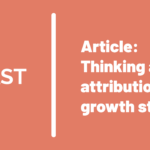For years, third-party cookies have been the backbone of digital tracking, and have enabled advertisers to tailor their strategies based on user behavior across different sites.
But things are changing: Google Chrome, used by 63.6 percent of internet users worldwide, has initiated a phase-out of third-party cookies – beginning with 1% of users in early 2024 and expanding to all users by Q3 2024.
We are witnessing the beginning of the end of the digital tracking era. But what does this mean for consumer brand marketers?
This shift is not just a technical update; it’s a seismic shift in the digital advertising ecosystem, posing significant challenges for businesses that have long relied on third-party cookie tracking. This decision will transform how user data is tracked and analyzed, and it aligns with a growing global emphasis on user privacy and data security.
For publishers, the implications are profound, with potential decreases in revenue from programmatic advertising and a pressing need to explore new user ID solutions.
For marketers, the deprecation of cookies is expected to disrupt the established methods of tracking, targeting, and measuring the effectiveness of online advertising campaigns. It’s also pushing marketers to urgently look for alternative, privacy-compliant methods of measurement.
This article will explore the dynamics of this shift, its impact on digital advertising, and the potential measurement options for consumer brands in a cookie-less world.
The Phase-Out Process and Timeline
Third-party cookies have been a fundamental component of how brands have tracked buyers across the internet for nearly three decades. They’ve supported a variety of online experiences that we’ve grown accustomed to, from simplifying logins to personalizing advertising.
However, their use for cross-site tracking has raised significant privacy concerns. As part of their Privacy Sandbox initiative, Google’s phase-out of third-party cookies starts now, in early 2024, and will impact 1% of Chrome users globally. It will be a pilot phase test to help understand the ramifications across various digital marketing platforms and prepare ad buyers and publishers for a completely cookie-less environment.
As we progress through 2024, Google plans to incrementally expand the scope of this phase-out. By Q3 2024, the company aims to extend the removal of third-party cookies to 100% of Chrome users, subject to regulatory approvals.
That said, marketers should expect this timeline to evolve, with significant developments and updates throughout 2024. This year will be pivotal in shaping the future of digital marketing, leading us to an even more privacy-centric marketing measurement world.
Implications for the Digital Advertising Industry
Marketers have traditionally used third-party cookies for targeted advertising, tracking user behavior across sites, and personalizing customer experiences. With the phase-out, these use cases, particularly in-depth user tracking and personalized targeting, will be significantly diminished.
Without these cookies, advertisers lose the ability to seamlessly track and understand user behavior across various online platforms. Ad buyers will lose visibility, and the absence of this granular tracking data will make it much more complicated for marketers to target and reach specific audience segments.
This change will also heavily impact the way brands measure paid search and paid social. Digital tracking was never well-suited for budget allocation decisions because it doesn’t measure incrementality but, now that the data publishers will have is more limited and biased, this hurdle is now even taller.
Brands need to adapt to this new reality. Luckily enough, you have options:
Alternative Measurement Methods in a Cookie-less World
- Marketing mix modeling (MMM):
Digital tracking / multi-touch attribution has become the default measurement method but, before the internet, how did marketers measure ads? You can’t click on a TV ad or on a radio spot.
In the 1960s, a statistical modeling technique was created to measure the contribution of each channel to sales–marketing mix modeling (MMM). MMM correlates spikes and dips in sales with events and actions in marketing. So, for example, if every time you increase paid advertising your organic sales do not increase, MMM can pick that up and show you it’s not incremental.
Traditional MMM was slow and couldn’t follow the pace of digital tracking, and so it lost popularity over time. But the tables turned: digital tracking started being ineffective, and improvements in technology and computation created a modern, quicker version of MMM.
And cookies being phased out presents MMM with a new opportunity: it only needs aggregate data and therefore doesn’t have any privacy concerns. No cookies, no problem.
- Conversion lift studies
Another way to measure incrementality is through conversion lift studies, aka tests and experiments. These studies typically involve creating a control group that is not exposed to the advertising campaign and a test group that is exposed.
By comparing the conversion rates between these groups, marketers can determine the actual lift, or increase in conversions, attributable to the campaign. In a cookie-less world, conversion lift studies gain significance as they don’t rely on individual user tracking across the internet.
Randomized controlled trials are the gold standard of tests, but they’re time-consuming and expensive to run. More typical experiments we recommend consumer brands to run are holdout tests and geo-lift tests.
Meta and Google, allow you to run CLS on the platform, where they define the parameters of the test and are responsible for dividing the audience, but you can also run them outside the ad platforms.
- Brand studies
MMM and CLS go very much hand-in-hand, but brand studies can be an alternative measurement method that approaches it from a different angle – a more qualitative one.
Brand studies involve conducting surveys with audiences who have been exposed to your advertising. These surveys measure the impact of various advertising channels or creative elements on specific Key Performance Indicators (KPIs) like ad recall or purchase intent.
This can provide insights into how a particular ad or campaign resonates with the target audience. However, one of the limitations of brand studies is that the insights they provide are often channel-specific and the findings might not provide a complete picture of a campaign’s overall effectiveness across the entire marketing mix.
TLDR:
- Google Chrome begins phasing out third-party cookies in 2024 with 1% of users in early 2024 and expanding to all users by Q3 2024.
- This change is another step towards limiting the visibility and effectiveness of digital tracking – a trend that will continue to limit marketers who rely on it.
- Marketing Mix Modeling (MMM) emerges as a key strategy, using aggregate data for privacy-compliant marketing and budget-allocation insights.
- Alternatives like conversion lift studies and brand studies offer effective ways to measure campaign impact without infringing on user privacy.



